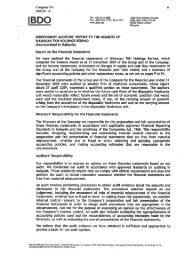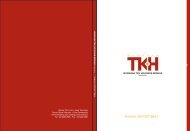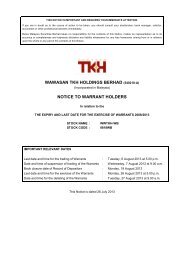ANNUAL REPORT 2012 - Wawasan TKH Holdings Berhad
ANNUAL REPORT 2012 - Wawasan TKH Holdings Berhad
ANNUAL REPORT 2012 - Wawasan TKH Holdings Berhad
Create successful ePaper yourself
Turn your PDF publications into a flip-book with our unique Google optimized e-Paper software.
052<br />
WAWASAN <strong>TKH</strong> HOLDINGS BERHAD (540218-A)<br />
<strong>ANNUAL</strong> <strong>REPORT</strong> <strong>2012</strong><br />
NOTES TO THE FINANCIAL STATEMENTS<br />
31 DECEMBER <strong>2012</strong> (cont’d)<br />
4. SIGNIFICANT ACCOUNTING POLICIES (cont’d)<br />
4.14 Provisions<br />
Provisions are recognised when there is a present obligation, legal or constructive, as a result of a<br />
past event, when it is probable that an outflow of resources embodying economic benefits would be<br />
required to settle the obligation and a reliable estimate can be made of the amount of the obligation.<br />
Where the Group expects a provision to be reimbursed (for example, under an insurance contract), the<br />
reimbursement is recognised as a separate asset but only when the reimbursement is virtually certain.<br />
If the effect of the time value of money is material, the amount of a provision would be discounted to its<br />
present value at a pre-tax rate that reflects current market assessments of the time value of money and<br />
the risk specific to the liability.<br />
Provisions are reviewed at the end of each reporting period and adjusted to reflect the current best<br />
estimate. If it is no longer probable that an outflow of resources embodying economic benefits would<br />
be required to settle the obligation, the provision would be reversed.<br />
Provisions are not recognised for future operating losses. If the Group has a contract that is onerous, the<br />
present obligation under the contract shall be recognised and measured as a provision.<br />
4.15 Contingent liabilities and contingent assets<br />
A contingent liability is a possible obligation that arises from past events whose existence would be<br />
confirmed by the occurrence or non-occurrence of one or more uncertain future events beyond the<br />
control of the Group or a present obligation that is not recognised because it is not probable that an<br />
outflow of resources will be required to settle the obligation. A contingent liability also arises in extremely<br />
rare cases where there is a liability that cannot be recognised because it cannot be measured reliably.<br />
The Group does not recognise a contingent liability but discloses its existence in the financial statements.<br />
A contingent asset is a possible asset that arises from past events whose existence would be confirmed<br />
by the occurrence or non-occurrence of one or more uncertain future event beyond the control of the<br />
Group. The Group does not recognise contingent asset but discloses its existence where inflows of<br />
economic benefits are probable, but not virtually certain.<br />
In the acquisition of subsidiaries by the Group under business combinations, contingent liabilities<br />
assumed are measured initially at their fair value at the acquisition date.<br />
4.16 Employee benefits<br />
4.16.1<br />
Short term employee benefits<br />
Wages, salaries, social security contributions, paid annual leave, paid sick leave, bonuses and<br />
non-monetary benefits are measured on an undiscounted basis and are expensed when employees<br />
rendered their services to the Group.<br />
Short term accumulating compensated absences such as paid annual leave are recognised as an<br />
expense when employees render services that increase their entitlement to future compensated<br />
absences. Short term non-accumulating compensated absences such as sick leave are recognised<br />
when the absences occur and they lapse if the current period’s entitlement is not used in full and do<br />
not entitle employees to a cash payment for unused entitlement on leaving the Group.<br />
Bonuses are recognised as an expense when there is a present, legal or constructive obligation to make<br />
such payments, as a result of past events and when a reliable estimate can be made of the amount of the<br />
obligation.<br />
4.16 2<br />
Defined contribution plans<br />
The Company and its subsidiaries incorporated in Malaysia make contributions to a statutory<br />
provident fund and foreign subsidiary makes contribution to its country’s statutory pension scheme.<br />
The contributions are recognised as a liability after deducting any contribution already paid and as an<br />
expense in the period in which the employees render their services.<br />
A subsidiary of the Group also pays fixed contributions based on the terms and conditions stipulated<br />
in the Collective Agreement with Non-Metallic Mineral Products Manufacturing Employees’ Union<br />
(‘NMPME’).







